Magical plants often have a long association with particular qualities, such as protection or help in romantic affairs. People often planted rowan as protection against witchcraft. The use of roses in love magic persists in the link between roses and romance.
We’ve looked before at the folklore of super toxic plants, as well as common garden flowers.
This time we’re looking at the folklore of poisonous plants that still possess magical properties! And remember, this post is for entertainment purposes only. It is not designed nor intended to replace medical advice. Do not consume or use any of these plants if you don’t know what you’re doing.
Read on to learn more about these three magical plants: larkspur, periwinkle, and wormwood!
Larkspur (Delphinium ajacis)
Larkspur is actually an annual member of the buttercup family Ranunculaceae. Butterflies and bees love it, but the fact it’s toxic puts off most other creatures! The Greeks saw dolphin shapes in the way the flower unfolded. This explains its botanical name, Delphinium ajacis (Baker 2011: 88).
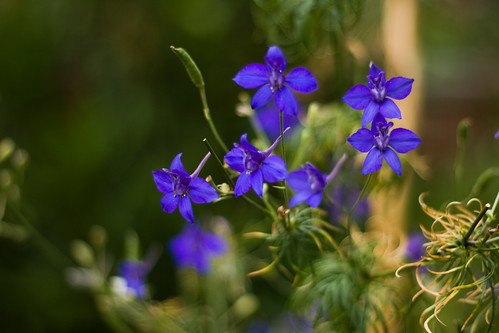
Thankfully, there’s not really much about the plant that would say “Hey, eat me!”. It’s more harmful to cattle than humans when ingested. Sheep are immune to its toxins.
Yet despite its toxicity, some think that soldiers used larkspur to help control body lice. This would explain its use in protection spells. People in Transylvania kept dried larkspur in their stables to protect animals from witchcraft. Larkspur could keep ghosts at bay, while the flowers also frighten off scorpions (Cunningham 1985: 152).
There are many links between larkspur and ‘seeing’, especially for scholars. They kept larkspur on their desks and glanced at it often to soothe their tired eyes (Baker 2011: 89). Meanwhile, people believed looking through bunches of larkspur at midsummer fires would protect the eyes from ailments for the coming year (Baker 2011: 89).
In the language of flowers, larkspur means levity, lightness, and an open heart (Dietz 2020: 64). But make sure you got the right colour. Pink larkspurs meant fickleness, while purple larkspurs meant haughtiness (Valentine 1867: 75). People once used its flowers to make blue dye.
Larkspur and Greek Myth
According to Aaron Atsma, the plant we call the hyacinth is not the flower in the myth of Hyakinthos and Apollo. It’s actually larkspur. The myth has a few variations, but in both, Apollo (god of the sun) and Zephyros (god of the wind) love Hyakinthos, the Spartan prince. In one variation, Hyakinthos chooses Zephyros. Apollo kills him in a fit of jealousy. In another variation, Apollo is playing quoits with Hyakinthos. The jealous Zephyros controls the wind to catch Apollo’s quoit. It strikes Hyakinthos in the head and kills him. In both tales, the hyakinthos plant, or larkspur, springs forth from his blood. An ‘ai’ appears on the petals, being the Greek word for ‘alas’. As a result, the larkspur is sacred to Apollo.
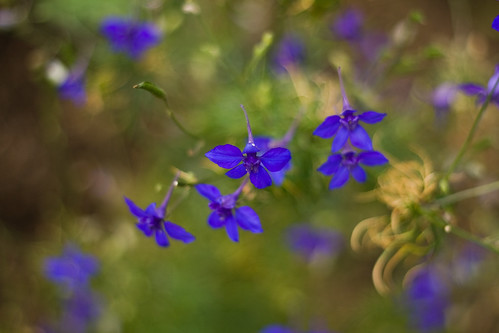
The larkspur also appears in another Greek myth, that of the death of Ajax. After his death, Achilles’ armour goes to Odysseus. Ajax goes mad and throws himself on his own sword. The larkspur grew from his blood, and the ‘AI’ on the petals coming from his name, Aias (Atsma 2000-2011). Finally, larkspur was apparently one of the flowers being gathered by Persephone before her abduction by Hades. She was also gathering rose, crocus, violet, iris, and lily (Atsma 2000-2011).
Periwinkle (Vinca major)
Periwinkle is also known as Sorcerer’s violet. The plant is also known as Creeping Myrtle, Joy on the Ground, and Devil’s Eye (Dietz 2020: 229). It’s also known as ‘cut finger’ from its use in treating wounds (Baker 2011: 121). Sir Francis Bacon believed binding its leaves around the leg would guard against cramp. It appeared as a remedy for boils, toothache, and nosebleeds in Oxfordshire (Baker 2011: 121). Too much can cause extremely low blood pressure.
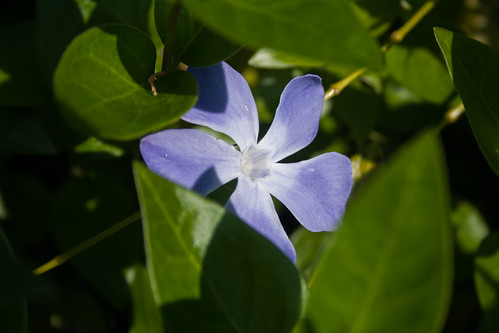
Periwinkle does actually have a range of medicinal uses. It contains vincamine which is used in modern medicine as a cerebral stimulant. This is interesting because the plant also represents early recollections, memories, and sweet remembrance (Dietz 2020: 229). Periwinkle is believed to be used to banish negative energy and restore mental clarity (Dietz 2020: 229). One snippet of folklore suggests that gazing at periwinkle flowers would restore lost memories (Dietz 2020: 229). Perhaps this is an example of magical plants having tangible effects.
Periwinkle grows naturally in graveyards so it gained many associations with death. Called ‘fiore di morte’ (death’s flower) in Italy, it appeared in funeral wreaths for children (Baker 2011: 121). Condemned men wore garlands of periwinkles as they travelled to the gallows in medieval England (Baker 2011: 121). Plucking it from a grave in Wales brought bad luck, and could even see you being haunted by the grave’s owner (Baker 2011: 121).
These protective qualities extended to the living, and people hung bunches or wreaths of periwinkle on front doors to protect those inside. Travellers might also carry periwinkle for protection. Which makes it an odd choice to associate with condemned men!
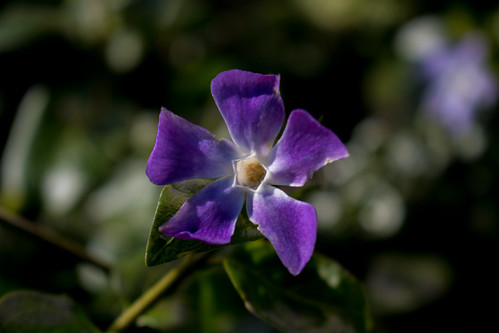
Periwinkles and Love
People stuffed the leaves of the plant into the marital bed to promote fidelity and happiness. Growing it outside your home also helped to encourage harmony inside. In the language of flowers, blue periwinkles represented early friendship. White periwinkles meant pleasures of memory (Valentine 1867: 82). The plant also appeared in recipes for love potions.
On Matthias Night (February 24), girls made two wreaths; one of straw, one of periwinkle. They headed to a running stream at midnight and laid the wreaths in the stream. Somehow, the folklore doesn’t say how, they also put a handful of ashes in the water. They danced around blindfolded beside the water, before choosing one of the three items. The periwinkle meant they would marry, the straw represented misfortune, and the ashes stood for death (Bogan, no date).
Wormwood (Artemisia Absinthium)
Wormwood contains glucoside absinthin, which use to flavour absinthe. Drinking too much can affect the sight, making most things appear yellow. It was also known as ‘madderwort’ (Dietz 2020: 30). Wormwood represents absence, adultery, bitterness, idolatry, and the torment of love. Yet in a true language of flowers contradiction, it also meant ‘Do not be discouraged’ (Dietz 2020: 30).
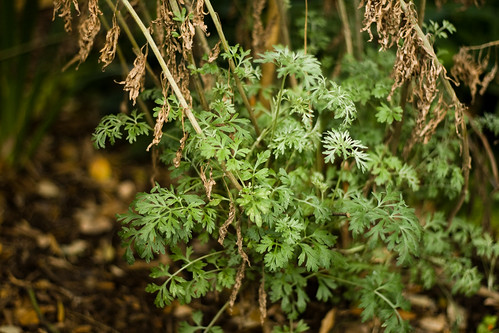
According to folklore, it sprung up in the trail of the Devil when he left the Garden of Eden (Dietz 2020: 30).
The Poison Garden website says that wormwood even plays a role in the Book of Revelations! “Chapter 8, verse 11 says, ‘And the name of the star is called Wormwood: and the third part of the waters became wormwood; and many men died of the waters, because they were made bitter’.” According to legend, the drink offered to Jesus during the crucifixion was wormwood and vinegar (Adams 2004: 16).
The Christian links don’t end there. Crusading knights carried wormwood in an attempt to stave off plague. People also used it as a flea repellant in medieval England so perhaps the knights were on to something. Wormwood can even be used to repel rusalki, the dangerous water spirits of Slavic folklore (Barber 2013: 20). Carrying a simple sprig could ward them off.

Its Latin name from from Artemis, the Greek goddess of chastity. The absinthium part of its name allegedly comes from a Greek word that means ‘undrinkable’. Historically people used it to cure intestinal worms, hence ‘wormwood’.
Yet another variation on the tale says that ‘wormwood’ comes from ‘wermut’, a German word meaning ‘preserver of the mind’. According to UsesOfHerbs.com, people in days gone by thought the plant could boost mental capabilities. It’s massively hallucinogenic so probably not. Its thujone content gives it psychoactive properties, which also makes consuming too much toxic (The Cunning Wife 2020).
Wormwood: The Third of Our Magical Plants
It’s also the third of our magical plants. Wormwood could be used to call spirits, to draw a lover, or to prevent strife or war (Dietz 2020: 30). An old love charm includes wormwood, along with marjoram, marigolds and thyme. Magical practitioners used it to boost divination and develop psychic powers, though I daresay its hallucinogenic qualities helped with this (Dietz 2020: 30). If you burned it in a graveyard, it could impel the spirits to appear and speak to the conjurer (Dietz 2020: 30). Wormwood is also supposed to protect against bewitchment (Dietz 2020: 30).
This protective quality would fit in with its use as a protective plant outside the home. I’m not sure how much its psychoactive properties contribute to its use in speaking to spirits, but wormwood seems to be a much beloved example of magical plants!
Over to you! Do you grow any of these magical plants?
References
Adams, Jack (2004) Hideous Absinthe: A History of the Devil in a Bottle, London: I.B.Tauris.
Atsma, Aaron (2000-2011), ‘Flora 1: Plants of Greek Myth’, Theoi Project, https://www.theoi.com/Flora1.html.
Baker, Margaret (2011), Discovering the Folklore of Plants, 3rd edition, Oxford: Shire Classics.
Barber, Elizabeth Wayland (2013), The Dancing Goddesses: Folklore, Archaeology, and the Origins of European Dance, New York: W.W. Norton & Company.
Bogan, Chas (no date), ‘Periwinkle’, Feri: American Traditional Witchcraft, http://feritradition.org/grimoire/garden/periwinkle.html.
Cunningham, Scott (1985) Cunningham’s Encyclopedia of Magical Herbs, Woodbury, MN: Llewellyn Worldwide.
Dietz, S. Theresa (2020), The Complete Language of Flowers: A Definitive and Illustrated History, New York: Wellfleet Press.
The Cunning Wife (2020), ‘The Defender at the Door: Wormwood Folklore and Household Uses’, Witches & Pagans, https://www.witchesandpagans.com/the-defender-at-the-door-wormwood-folklore-and-household-uses.html.
Valentine, Laura (1867), The language and sentiment of flowers, London: Frederick Warne and Co.
Nutty about folklore and want more?
Add your email below and get these posts in your inbox every week.
You'll also get my 5-step guide to protecting your home using folklore!








love these posts – I will have to keep coming back to them for story ideas 😀
I’ll keep them coming!
Fascinating! Thanks for sharing this!
No problem – glad you enjoyed it!
Love the idea of a part of the night sky turning into tiny litle flowers. Great post. Well researched.
Also, didn’t Snape ask Harry what wormwood was in the first potions class?
That was Wonderful on these Lovely Flowers. Thank You Very Much!! 😸😊💖🌻🌷🌼🌈🌞
My pleasure!